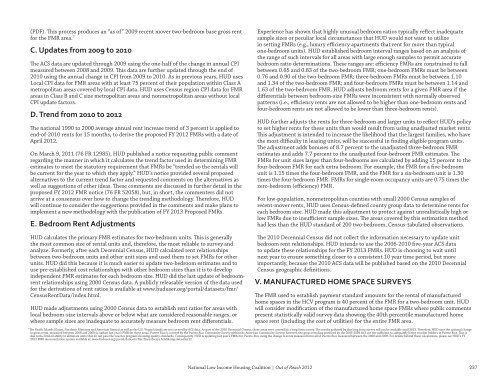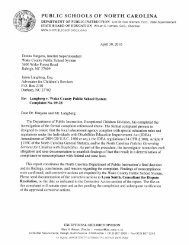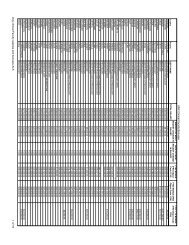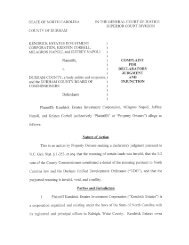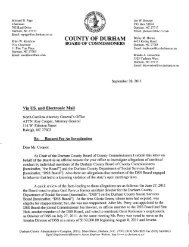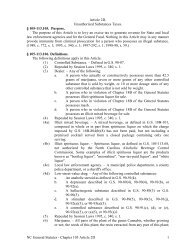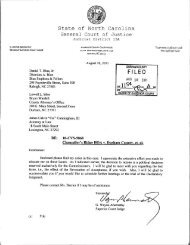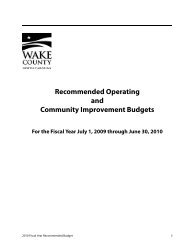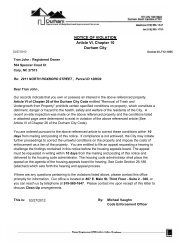Out of Reach 2012 - National Low Income Housing Coalition
Out of Reach 2012 - National Low Income Housing Coalition
Out of Reach 2012 - National Low Income Housing Coalition
You also want an ePaper? Increase the reach of your titles
YUMPU automatically turns print PDFs into web optimized ePapers that Google loves.
(PDF). This process produces an “as <strong>of</strong>” 2009 recent mover two-bedroom base gross rent<br />
for the FMR area. 7<br />
C. Updates from 2009 to 2010<br />
The ACS data are updated through 2009 using the one-half <strong>of</strong> the change in annual CPI<br />
measured between 2008 and 2009. This data are further updated through the end <strong>of</strong><br />
2010 using the annual change in CPI from 2009 to 2010. As in previous years, HUD uses<br />
Local CPI data for FMR areas with at least 75 percent <strong>of</strong> their population within Class A<br />
metropolitan areas covered by local CPI data. HUD uses Census region CPI data for FMR<br />
areas in Class B and C size metropolitan areas and nonmetropolitan areas without local<br />
CPI update factors.<br />
D. Trend from 2010 to <strong>2012</strong><br />
The national 1990 to 2000 average annual rent increase trend <strong>of</strong> 3 percent is applied to<br />
end-<strong>of</strong>-2010 rents for 15 months, to derive the proposed FY <strong>2012</strong> FMRs with a date <strong>of</strong><br />
April <strong>2012</strong>.<br />
On March 9, 2011 (76 FR 12985), HUD published a notice requesting public comment<br />
regarding the manner in which it calculates the trend factor used in determining FMR<br />
estimates to meet the statutory requirement that FMRs be “trended so the rentals will<br />
be current for the year to which they apply.” HUD’s notice provided several proposed<br />
alternatives to the current trend factor and requested comments on the alternatives as<br />
well as suggestions <strong>of</strong> other ideas. These comments are discussed in further detail in the<br />
proposed FY <strong>2012</strong> FMR notice (76 FR 52058), but, in short, the commenters did not<br />
arrive at a consensus over how to change the trending methodology. Therefore, HUD<br />
will continue to consider the suggestions provided in the comments and make plans to<br />
implement a new methodology with the publication <strong>of</strong> FY 2013 Proposed FMRs.<br />
E. Bedroom Rent Adjustments<br />
Experience has shown that highly unusual bedroom ratios typically reflect inadequate<br />
sample sizes or peculiar local circumstances that HUD would not want to utilize<br />
in setting FMRs (e.g., luxury efficiency apartments that rent for more than typical<br />
one-bedroom units). HUD established bedroom interval ranges based on an analysis <strong>of</strong><br />
the range <strong>of</strong> such intervals for all areas with large enough samples to permit accurate<br />
bedroom ratio determinations. These ranges are: efficiency FMRs are constrained to fall<br />
between 0.65 and 0.83 <strong>of</strong> the two-bedroom FMR; one-bedroom FMRs must be between<br />
0.76 and 0.90 <strong>of</strong> the two-bedroom FMR; three-bedroom FMRs must be between 1.10<br />
and 1.34 <strong>of</strong> the two-bedroom FMR; and four-bedroom FMRs must be between 1.14 and<br />
1.63 <strong>of</strong> the two-bedroom FMR. HUD adjusts bedroom rents for a given FMR area if the<br />
differentials between bedroom-size FMRs were inconsistent with normally observed<br />
patterns (i.e., efficiency rents are not allowed to be higher than one-bedroom rents and<br />
four-bedroom rents are not allowed to be lower than three-bedroom rents).<br />
HUD further adjusts the rents for three-bedroom and larger units to reflect HUD’s policy<br />
to set higher rents for these units than would result from using unadjusted market rents.<br />
This adjustment is intended to increase the likelihood that the largest families, who have<br />
the most difficulty in leasing units, will be successful in finding eligible program units.<br />
The adjustment adds bonuses <strong>of</strong> 8.7 percent to the unadjusted three-bedroom FMR<br />
estimates and adds 7.7 percent to the unadjusted four-bedroom FMR estimates. The<br />
FMRs for unit sizes larger than four-bedrooms are calculated by adding 15 percent to the<br />
four-bedroom FMR for each extra bedroom. For example, the FMR for a five-bedroom<br />
unit is 1.15 times the four-bedroom FMR, and the FMR for a six-bedroom unit is 1.30<br />
times the four-bedroom FMR. FMRs for single-room occupancy units are 0.75 times the<br />
zero-bedroom (efficiency) FMR.<br />
For low-population, nonmetropolitan counties with small 2000 Census samples <strong>of</strong><br />
recent-mover rents, HUD uses Census-defined county group data to determine rents for<br />
each bedroom size. HUD made this adjustment to protect against unrealistically high or<br />
low FMRs due to insufficient sample sizes. The areas covered by this estimation method<br />
had less than the HUD standard <strong>of</strong> 200 two-bedroom, Census-tabulated observations.<br />
HUD calculates the primary FMR estimates for two-bedroom units. This is generally<br />
the most common size <strong>of</strong> rental units and, therefore, the most reliable to survey and<br />
analyze. Formerly, after each Decennial Census, HUD calculated rent relationships<br />
between two-bedroom units and other unit sizes and used them to set FMRs for other<br />
units. HUD did this because it is much easier to update two-bedroom estimates and to<br />
use pre-established cost relationships with other bedroom sizes than it is to develop<br />
independent FMR estimates for each bedroom size. HUD did the last update <strong>of</strong> bedroomrent<br />
relationships using 2000 Census data. A publicly releasable version <strong>of</strong> the data used<br />
for the derivations <strong>of</strong> rent ratios is available at www.huduser.org/portal/datasets/fmr/<br />
CensusRentData/index.html.<br />
HUD made adjustments using 2000 Census data to establish rent ratios for areas with<br />
local bedroom-size intervals above or below what are considered reasonable ranges, or<br />
where sample sizes are inadequate to accurately measure bedroom rent differentials.<br />
The 2010 Decennial Census did not collect the information necessary to update unit<br />
bedroom rent relationships. HUD intends to use the 2006-2010 five-year ACS data<br />
to update these relationships for the FY 2013 FMRs. HUD is choosing to wait until<br />
next year to ensure something closer to a consistent 10 year time period, but more<br />
importantly, because the 2010 ACS data will be published based on the 2010 Decennial<br />
Census geographic definitions.<br />
V. MANUFACTURED HOME SPACE SURVEYS<br />
The FMR used to establish payment standard amounts for the rental <strong>of</strong> manufactured<br />
home spaces in the HCV program is 40 percent <strong>of</strong> the FMR for a two-bedroom unit. HUD<br />
will consider modification <strong>of</strong> the manufactured home space FMRs where public comments<br />
present statistically valid survey data showing the 40th percentile manufactured home<br />
space rent (including the cost <strong>of</strong> utilities) for the entire FMR area.<br />
7<br />
The Pacific Islands (Guam, Northern Marianas and American Samoa) as well as the U.S. Virgin Islands are not covered by ACS data. As part <strong>of</strong> the 2010 Decennial Census, these areas were covered by a long-form survey. The results gathered by this long form survey will not be available until <strong>2012</strong>. Therefore, HUD uses the national change<br />
in gross rents, measured between 2008 and 2009 to update last year’s FMR for these areas. Puerto Rico is covered by the Puerto Rico Community Survey within the American Community Survey; however, the gross rent data produced by the 2005-2009 ACS are not sufficient to adequately house voucher holders in Puerto Rico. This is<br />
due to the limited ability to eliminate units that do not pass the voucher program’s housing quality standards. Consequently, HUD is updating last year’s FMRs for Puerto Rico using the change in rents measured from all <strong>of</strong> Puerto Rico measured between the 2008 and 2009. For details behind these calculations, please see HUD’s FY<br />
<strong>2012</strong> FMR documentation system available at: www.huduser.org/portal/datasets/fmr/fmrs/docsys.html&data=fmr12<br />
<strong>National</strong> <strong>Low</strong> <strong>Income</strong> <strong>Housing</strong> <strong>Coalition</strong> | <strong>Out</strong> <strong>of</strong> <strong>Reach</strong> <strong>2012</strong> 237<br />
<strong>National</strong> <strong>Low</strong> <strong>Income</strong> <strong>Housing</strong> <strong>Coalition</strong> | <strong>Out</strong> <strong>of</strong> <strong>Reach</strong> <strong>2012</strong> 237


